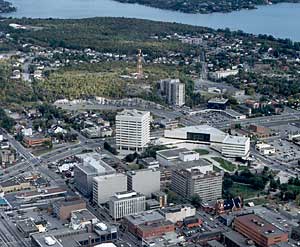This great recession is a tough time for a startup, but a group of architects and boosters in the Canadian city of Sudbury think it’s just the right moment for a new school of architecture. They’re gathering support for the planned Northern Ontario School of Architecture (NOSOA), which would be Canada’s first new architecture school in four decades.

Blaine Nicholls, a retired architect who chairs the school’s steering committee, argues that NOSOA—which would accept its first class in 2011—would bring new energy to Sudbury, a city of 150,000 that’s home to Laurentian University but whose economy has been centered on forestry and nickel mining.
Starting with its first class of 70 undergraduate and professional-degree students, NOSOA “would bring hundreds of people downtown, which has a direct economic impact,” Nicholls says. “But most important [would be] the impact on the creative culture within the area. Schools of architecture are unique because you have some of the very best university students and faculty, and having people like that work on a downtown can have a real creative impact.”
The school is being planned in association with Laurentian University, which is likely to give its formal blessing for a curriculum this month. But the city of Sudbury is also a partner, pledging $10 million (US $8.92 million) toward estimated capital costs of $35 million (US $31.2 million). Tuition rates would fall in line with Ontario schools, where graduate architecture programs charge between $6,000 and $7,500 (Canadian) per year.
In part the NOSOA is following an example of a strong school in the same province: the University of Waterloo School of Architecture, in southern Ontario, which in 2004 opened a satellite campus in Cambridge, a fading manufacturing center in a booming high-tech belt. Occupying an old textile mill in the city center, the school has become an engine for economic and cultural activity.
Sudbury’s agenda is a bit different, though: Located 250 miles from a metropolis and surrounded by boreal forest, the city is more attuned to the culture and economy of the rural Arctic North than Canada’s urban centers.
To that end, NOSOA’s mandate includes attention to sustainability and the specific needs of Northern Ontario, “which doesn’t have a strong creative culture,” Nicholls says. Around the world, “the North generally is an area where resources are extracted—except Scandinavia, where the economy is driven by value-added design,” he adds. “When you think of Scandinavia, you don’t think of them as producers of woodchips and two-by-fours. We’re looking at the Ikea model here.”
That argument should help with the biggest hurdle: getting approval from government, mostly the province of Ontario, for the program. The NOSOA group is optimistic but conditions are tough: the Canadian economy and public sector haven’t been as hard hit as their U.S. counterparts, but post-secondary institutions are coping with budget cuts and tuition hikes.
But Ontario recently commissioned economist Richard Florida—who now lives here, and teaches at the University of Toronto—to report on how to update its economy, and he (working with Toronto business school dean Roger Martin) concluded that post-secondary education and creative capacity are crucial ingredients. NOSOA could be just the thing, Nicholls says: “We’re making a school that fits perfectly with those ideas.”




Post a comment to this article
Report Abusive Comment